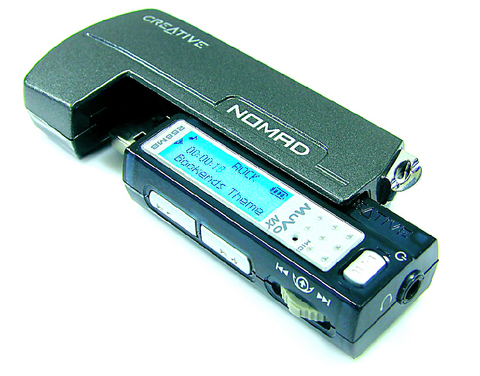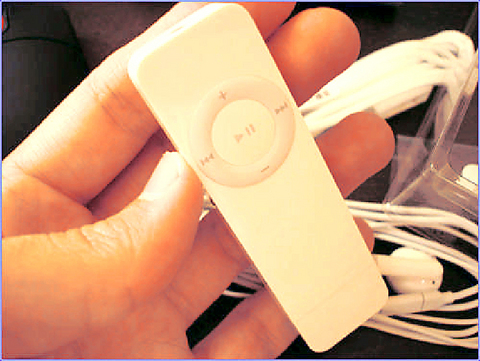Despite the fact that the gadgets have been around for years already, flash-memory-based music players are getting a lot of press with the recent release of Apple's iPod Shuffle, the company's attempt to capture the 30 percent of the portable-music-player market it doesn't already dominate.
The release of the iPod Shuffle was announced at the beginning of last month and Taiwanese customers who ordered it then are now getting calls to come pick it up.
But if the Shuffle has you mulling the idea of joining the iPod revolution, you owe it to yourself to check out the competitors Apple had in its sights when designing a wearable player. Doing so is a lesson in what the company did right and where it may have missed its mark.

PHOTO COURTESY OF IRIVER
The benefit of flash-memory players is that there are no moving parts. Harddrive players such as the regular iPod or iPod mini have a mechanism that reads a disk. If the device is dropped -- or, in some cases, if it bounces while you're jogging -- the mechanism can skip, or break altogether. Not so with a solid-state flash memory player. The downside, however, is that flash memory currently allows for up to only 1GB (the most popular models are 256MB and 512MB) of storage space.
Of course, this limited storage capacity is only a problem if you want to take most of your music library with you (i.e. when you're going on vacation).
At such times the roughly 120 four-minute-long songs you can fit on a 512MB flash memory player might get monotonous. But if you're simply going to work, to the gym or on a bicycle ride, a pit stop at your computer before heading out will allow you to swap out some eight hours of music in just a few minutes.

PHOTO COURTESY OF CREATIVE
One of the flash-memory-player companies that has been in the business the longest is Nomad, whose Creative brand of players has sold steadily for several years. Their latest volley in the wearable player wars is the Creative MuVo.
The MuVo comes in a variety of models. The introductory MuVo offers 64MB or 128 MB of storage space, making it already something of a dinosaur. (The company's literature boasts that the 128MB model can hold 88 floppies worth of data! Floppies!?)
The MuVo TX model is larger, with 512MB of storage capacity, the FM version (NT$3,900) has built-in FM radio capability and the NX version has voice-recording capabilities.

PHOTO COURTESY OF APPLE
The unique thing about the MuVo is that it's two pieces; a USB storage stick that slides into a sheath that houses the device's additional features.
The MuVo is making in-roads in Hong Kong among commuters who want a little more than the previous generation of flash-memory players offered; in other words the FM radio or dictation capability.
But if that's the type of device you're looking for, an iRiver player is worth a look. Earning top style points is iRiver's N10 Jewelry model (NT$7,000/512MB version). It streamlines all the basics of a solid-state music player (and adds a voice recorder) into a piece smaller than a pack of gum that doesn't look out of place around your neck when you're not listening to it. It's just 2.7cm wide, 5cm long and 1.3cm thick -- small enough and stylish enough that you have to look twice before realizing it's an electronic device. In fact, it's designed to be worm as jewelry.
The 16-shade OLED screen can generate a level meter, bolts of lightning or a dancing figure that moves to the beat of the music.
Another of the N10's design innovations is the fact that its ear-bud-style speakers are built into the lanyard. The cap that holds the lanyard can be removed and the unit stuffed into a pocket if you so desire, but the amount of slack wire that is taken up by combining the lanyard and ear-bud speakers makes other models look comparatively cumbersome. This seems a small point until you've seen the earphone wire of an iPod Shuffle or the Nomad flinging around wildly on the treadmill or waiting to get caught in the door of a cab.
Apple's iPod Shuffle (NT$3,100/512MB) is a rather bold departure from the designs above. There is no LED screen and users are given the option of having the Shuffle play their music in a predetermined order or in its namesake mode.
Apple has also managed to do away with a lot of the price compared with their iPod or iPod Mini models. It's portable music at its simplest.
Having seen each of these models and tried them out, the iPod is the most striking, but not in a pleasing way. It's the first feature you notice of anyone wearing one. It's a fashion statement, but more statement than fashion. The iRiver, by comparison, is sleek and stylish and gives you control over your music. The Nomad Muvo falls short.
Regarding sound quality, keep in mind that headphones play an arguably more important part than any other component (amplification being their only competitor) and that most portable music players ship with inexpensive ear-bud-style speakers.
Simply plugging in better-quality headphones can create more problems than it fixes if the headphones you're plugging in require an amplifier to bring out their full range. Of course, strapping an amplifier to your belt and lugging around a pair of hefty headphones defeats the purpose of buying a wearable player.
The practical solution then, is to find a pair of ear-bud speakers that you like better than the included pair.
This is a matter of personal taste, though some brands are clearly better-sounding than others. Audio-Technica makes a wide range of ear-bud speakers that get expensive quickly, largely for the materials they're made of -- titanium, teak wood, gold plating, etc, but even their bottom-shelf models sound great.
One last thought regarding flash-memory music players and sound quality: The best sound I've heard from any device I've plugged into in recent months came from a Motorola E680 smart phone. iPod isn't the only answer.

June 9 to June 15 A photo of two men riding trendy high-wheel Penny-Farthing bicycles past a Qing Dynasty gate aptly captures the essence of Taipei in 1897 — a newly colonized city on the cusp of great change. The Japanese began making significant modifications to the cityscape in 1899, tearing down Qing-era structures, widening boulevards and installing Western-style infrastructure and buildings. The photographer, Minosuke Imamura, only spent a year in Taiwan as a cartographer for the governor-general’s office, but he left behind a treasure trove of 130 images showing life at the onset of Japanese rule, spanning July 1897 to

In an interview posted online by United Daily News (UDN) on May 26, current Chinese Nationalist Party (KMT) Chairman Eric Chu (朱立倫) was asked about Taichung Mayor Lu Shiow-yen (盧秀燕) replacing him as party chair. Though not yet officially running, by the customs of Taiwan politics, Lu has been signalling she is both running for party chair and to be the party’s 2028 presidential candidate. She told an international media outlet that she was considering a run. She also gave a speech in Keelung on national priorities and foreign affairs. For details, see the May 23 edition of this column,

At Computex 2025, Nvidia CEO Jensen Huang (黃仁勳) urged the government to subsidize AI. “All schools in Taiwan must integrate AI into their curricula,” he declared. A few months earlier, he said, “If I were a student today, I’d immediately start using tools like ChatGPT, Gemini Pro and Grok to learn, write and accelerate my thinking.” Huang sees the AI-bullet train leaving the station. And as one of its drivers, he’s worried about youth not getting on board — bad for their careers, and bad for his workforce. As a semiconductor supply-chain powerhouse and AI hub wannabe, Taiwan is seeing

Jade Mountain (玉山) — Taiwan’s highest peak — is the ultimate goal for those attempting a through-hike of the Mountains to Sea National Greenway (山海圳國家綠道), and that’s precisely where we’re headed in this final installment of a quartet of articles covering the Greenway. Picking up the trail at the Tsou tribal villages of Dabang and Tefuye, it’s worth stocking up on provisions before setting off, since — aside from the scant offerings available on the mountain’s Dongpu Lodge (東埔山莊) and Paiyun Lodge’s (排雲山莊) meal service — there’s nowhere to get food from here on out. TEFUYE HISTORIC TRAIL The journey recommences with